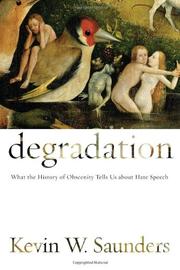| Listing 1 - 2 of 2 |
Sort by
|

ISBN: 9780814708750 0814708757 9780814741450 0814741452 Year: 2010 Publisher: New York : New York University Press,
Abstract | Keywords | Export | Availability | Bookmark
 Loading...
Loading...Choose an application
- Reference Manager
- EndNote
- RefWorks (Direct export to RefWorks)
Throughout history obscenity has not really been about sex but about degradation. Sexual depictions have been suppressed when they were seen as lowering the status of humans, furthering our distance from the gods or God and moving us toward the animals. In the current era, when we recognize ourselves and both humans and animals, sexual depiction has lost some of its sting. Its degrading role has been replaced by hate speech that distances groups, whether based on race, ethnicity, gender, or sexual orientation, not only from God but from humanity to a subhuman level. In this original study of the relationship between obscenity and hate speech, First Amendment specialist Kevin W. Saunders traces the legal trajectory of degradation as it moved from sexual depiction to hateful speech. Looking closely at hate speech in several arenas, including racist, homophobic, and sexist speech in the workplace, classroom, and other real-life scenarios, Saunders posits that if hate speech is today’s conceptual equivalent of obscenity, then the body of law that dictated obscenity might shed some much-needed light on what may or may not qualify as punishable hate speech.
Law --- Hate speech --- Hate speech. --- Obscenity (Law) --- Pornography.
Book
ISBN: 0199996849 9780199996841 129995636X 9781299956360 9780199916269 0199916268 Year: 2013 Publisher: New York : Oxford University Press,
Abstract | Keywords | Export | Availability | Bookmark
 Loading...
Loading...Choose an application
- Reference Manager
- EndNote
- RefWorks (Direct export to RefWorks)
For the first time, Oxford University Press equips students with an accessible guide to exercising their understanding of the fundamental law of the United States on law school exams. In Constitutional Law: Model Problems and Outstanding Answers, Kevin Saunders and Michael Lawrence help students demonstrate their knowledge of constitutional law in the structured and sophisticated manner that professors expect on law school exams. The book provides clear introductions to major topics in constitutional law, provides hypotheticals similar to those that students can expect to see on an exam, including multi-issue questions, and offers model answers to those hypotheticals. Professors Saunders and Lawrence then also coach students in how to evaluate their own work with a comprehensive self-analysis section. This book prepares students by challenging them to use the law they learn in class while also explaining the best way to express an answer on law school exams.
| Listing 1 - 2 of 2 |
Sort by
|

 Search
Search Feedback
Feedback About UniCat
About UniCat  Help
Help News
News